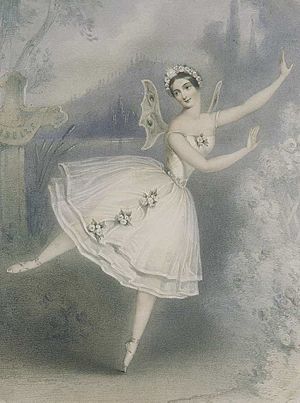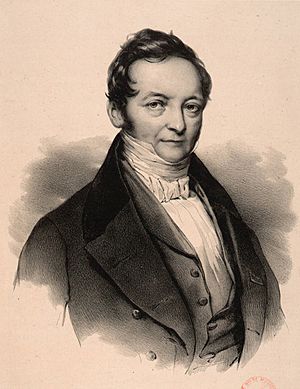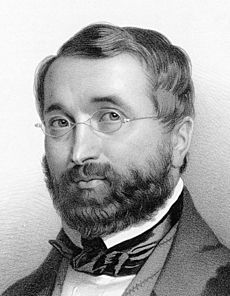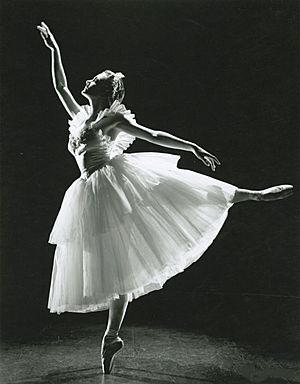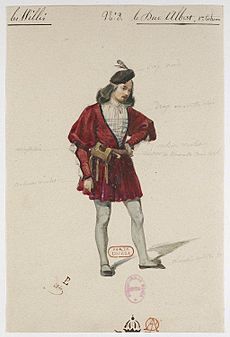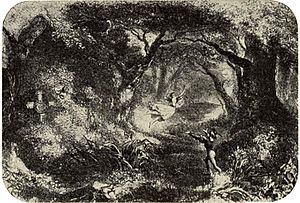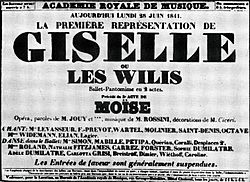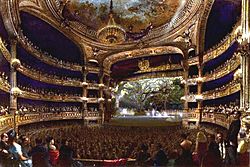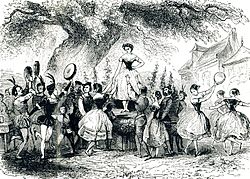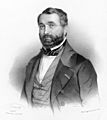Giselle facts for kids
Quick facts for kids Giselle |
|
|---|---|
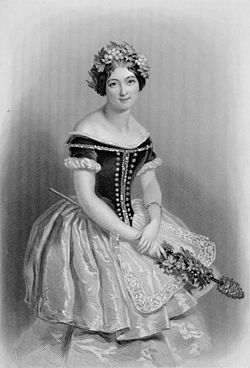
Carlotta Grisi as Giselle, 1841
|
|
| Choreographed by | Jean Coralli Jules Perrot |
| Composed by | Adolphe Adam |
| Libretto by | Jules-Henri Vernoy de Saint-Georges Théophile Gautier |
| Based on | Heinrich Heine's De l'Allemagne Victor Hugo's "Fantômes" from Les Orientales |
| Date of premiere | Monday 28 June 1841 |
| Place of premiere | Théâtre de l'Académie Royale de Musique |
| Original ballet company | Ballet du Théâtre de l'Académie Royale de Musique |
| Characters | Giselle Albrecht Hilarion Myrtha Bathilde Prince of Courland Berthe Wilfrid Peasants, Nobles, Wilis |
| Designs by | Pierre Ciceri (scenery) Paul Lormier (costumes) |
| Setting | Rhine Valley Renaissance |
| Created for | Carlotta Grisi |
| Genre | Ballet-fantastique |
| Type | Romantic ballet |
Giselle; or, The Wilis is a famous romantic ballet with two acts. The story was written by Jules-Henri Vernoy de Saint-Georges and Théophile Gautier. They got their ideas from a short story by Heinrich Heine and a poem by Victor Hugo. Adolphe Adam created the music for the ballet. The dances were designed by Jean Coralli and Jules Perrot. The first person to dance the main role of Giselle was Carlotta Grisi. Pierre Ciceri designed the beautiful scenery.
The ballet takes place in Germany during the Renaissance period. Giselle is a young village girl. She falls in love with Albrecht, who is actually a prince pretending to be a simple peasant. Giselle is heartbroken when she finds out Albrecht is engaged to Princess Bathilde. She becomes very sad and dies. Later, she rises from her grave as a spirit. She wants to protect Albrecht from the Wilis. The Wilis are the ghosts of young women who died before their wedding day. They force men to dance until they die.
Giselle was first shown in Paris on June 28, 1841, at the Théâtre de l'Académie Royale de Musique. It was a huge success! Soon, other ballet companies in Europe, Russia, and the United States started performing it. Carlotta Grisi became as famous as Marie Taglioni, who was the greatest ballerina of that time. Many people consider Giselle to be the perfect example of a romantic ballet.
Contents
- What Happens in the Story?
- How the Ballet Was Created
- The Music of Giselle
- How the Dances Were Made
- Costumes and Sets
- First Performance and Success
- Main Characters in the First Show
- What People Thought of Giselle
- Early Performances Around the World
- How the Music is Organized
- Images for kids
- See also
What Happens in the Story?
Act 1: A Village Love Story
The ballet begins on a sunny autumn morning in Germany. Giselle and Albrecht are deeply in love. However, Hilarion, a gamekeeper, also loves Giselle. She doesn't love him back, which makes him very jealous. He plans to get revenge. Hilarion suspects that Albrecht is not who he seems to be. Albrecht is actually a Duke, pretending to be a peasant.
The village boys and girls start to dance a waltz. Giselle asks Albrecht to dance with her. Giselle's mother worries because her daughter has a weak heart. She warns Giselle that too much dancing could make her sick and even die. She is also afraid Giselle might become one of the Wilis. The Wilis are ghostly women who dance men to death.
Suddenly, a hunting horn sounds in the distance. Albrecht gets nervous and quickly leaves with the other peasants. The Prince of Courland, his daughter Bathilde, and their royal friends arrive. They are looking for a place to rest after their hunt. Giselle and her mother offer them food and drinks. Bathilde is kind to Giselle. They both share that they are in love and about to be married.
Albrecht returns with the peasants. Bathilde then reveals that Albrecht is her future husband. Giselle is completely shocked and heartbroken. She becomes very upset and dies in her mother's arms. The angry peasants chase Albrecht away.
Act 2: The World of the Wilis
It is midnight in a dark, spooky forest. There's a pool of water nearby. Gamekeepers enter, but Hilarion warns them that the place is haunted by the Wilis. The gamekeepers quickly run away. Myrtha, the Queen of the Wilis, rises from the plants to call her ghostly dancers together. Giselle is about to become one of them. She rises from her grave and begins to dance.
Albrecht comes to pray at Giselle's grave. He sees Giselle, and they dance together. The Wilis find Hilarion and force him to dance until he falls into the pool and dies. The Queen of the Wilis wants Albrecht to die too. But Giselle tries to save him. As day breaks, the Wilis disappear. Giselle returns to her grave. Bathilde and her friends arrive, looking for Albrecht. He falls into their arms, completely exhausted.
How the Ballet Was Created
The Idea for Giselle
In 1841, Théophile Gautier shared how Giselle came to be. He had read about the Wilis in a book by Heinrich Heine. He thought these ghostly spirits would be perfect for a ballet. He planned their story for Act 2. For Act 1, he was inspired by a poem by Victor Hugo. This poem was about a beautiful 15-year-old Spanish girl who loved to dance. She died from a chill after dancing too much at a ball.
Heine's story described the Wilis as young women who died before their wedding day. They rise from their graves at night to dance. Any young man who crosses their path is forced to dance until he dies. Some stories also said the Wilis were young women who had been left by their lovers and became vampires, which is why they hated men.
Gautier thought combining Heine's Wilis and Hugo's dancing girl would make a great ballet. His first idea was a grand ballroom where the Wilis would cast a spell, making everyone dance non-stop. Giselle would try to stop her lover from dancing with other girls. Then, the Queen of the Wilis would touch Giselle's heart, and she would die.
Gautier wasn't happy with this idea because it was mostly just dances. He asked Jules-Henri Vernoy de Saint-Georges, who had written many ballet stories, for help. Saint-Georges liked Gautier's idea of the fragile girl and the Wilis. He wrote the story of Giselle as we know it today in just three days.
The director of the Paris Opéra, Léon Pillet, wanted to show off a talented young Italian dancer named Carlotta Grisi. He needed a good story, and Giselle was perfect. Grisi loved the story, so the ballet began to be developed right away.
The Music of Giselle
Adolphe Adam was a very popular composer of ballet and opera music in France. He worked very quickly and finished the music for Giselle in about two months. The music was written in a smooth, song-like style called cantilena.
Adam used special musical ideas called leitmotifs in the ballet. A leitmotif is a short tune that is linked to a certain character, event, or idea. For example, Giselle has her own tune, and so does Albrecht. Hilarion's tune plays every time he enters, sounding a bit like a fate theme. There's also a tune for the "he loves me, he loves me not" flower game in Act 1. This tune appears again when Giselle goes mad and in Act 2. The Wilis also have their own tune, which you hear in the beginning and when they appear. The sound of a hunting horn signals sudden surprises, like when Albrecht is revealed as a nobleman.
Most of the music was original from Adam. However, he did use a few parts from other composers. Two pieces by Johann Friedrich Franz Burgmüller were also added to the ballet, including a waltz and some dances for Giselle's friends. We don't know who added these pieces.
One dance historian, Cyril W. Beaumont, said that while the music of Giselle might not be considered "great music," it is perfect for the ballet. He wrote that it is "danceable" and creates the right "colour and mood" for the story. He also mentioned that the melodies have a "nostalgic quality" that still feels magical today.
How the Dances Were Made
Jean Coralli and Jules Perrot created the dances for Giselle. Perrot and Carlotta Grisi were a couple, and Perrot designed all of Grisi's dances and her acting parts (called pantomime). Everyone in the Paris dance world knew Perrot designed Grisi's dances, but he wasn't officially given credit. This was probably to stop him from earning money from the ballet.
Perrot liked dramatic moves. He planned for Giselle to fly through the air on wires in Act 2. But Grisi was scared. A stagehand tried it and crashed into the scenery, so the flying parts were removed.
Cyril Beaumont explains that Giselle combines two main parts: dance and mime (acting without words). In Act 1, there are short mime scenes and dances mixed with mime. In Act 2, mime becomes fully part of the dance. The dance steps used are simple, like:
- Movements: developpe (unfolding the leg), grand rond de jambe (large circle of the leg)
- Poses: arabesque (a pose with one leg extended behind), attitude (a pose with one leg lifted and bent)
- Gliding steps: chasse, glissade, pas de basque, pas de bouree
- Hopping steps: ballone, temps leve
- Turning steps: pirouette, petit tour, tour en l'air
- Leaping steps: ballotte, entrechat, sisonne, rond de jambe en l'air saute, cabriole, jete, grande jete, soubresaut
Beaumont thought these simple steps were chosen to allow the dancers to express a lot of emotion.
Some parts of Giselle have changed since the first performance. For example, Giselle's mime scene in Act 1 where she talks about her dream is often cut. The peasant pas de deux (a dance for two) in Act 1 is shorter now. The Prince and Bathilde used to enter on horseback, but today they walk. In the original show, they were there when Giselle died, but now they leave before that happens. The special machines that made Giselle fly or disappear are not used anymore. Sometimes, a trapdoor is used to make Giselle rise from her grave and sink back into it.
Costumes and Sets
Costumes for the Characters
The ballet's story doesn't say exactly when it takes place. Paul Lormier, the main costume designer, probably talked with Gautier about this. It's also possible that the director, Pillet, wanted to save money. He might have decided to use the many Renaissance-style costumes already in the Opéra's storage. These costumes might have been from other operas. Lormier designed the costumes for the main characters. His costumes were used until the ballet stopped being performed in 1853.
When Giselle was brought back in 1863, new costumes were designed by Alfred Albert, Lormier's assistant. Albert's costumes are more like what you see in modern productions today.
Designing the Stages
Pierre-Luc-Charles Cicéri was the main set designer at the Paris Opéra for many years. He designed the sets for the first Giselle show. Gautier wasn't very specific about where the ballet was set, only saying it was in "some mysterious corner of Germany... on the other side of the Rhine."
Giselle had a very long rehearsal time of two months. Even so, Ciceri didn't have enough time to design sets for both acts. He focused on Act 2. The sets for Act 1 were actually from another ballet from 1838. An old drawing from 1845 shows Giselle's cottage with a straw roof on the left, and Albrecht's cottage on the right. Large trees frame the cottages, and in the distance, you can see a castle and vineyards. Even though this scene wasn't made for Giselle, it's still the model for most modern shows.
The drawing for Act 2 shows a dark forest with a pool of water. Old trees form an arch overhead. On the left, there's a marble cross with 'Giselle' written on it. From the cross hangs the crown of grape leaves that Giselle wore as Queen of the Vintage. The stage had many thick weeds and wildflowers to make it look like a real forest. The lights were turned down low to create a mysterious and scary mood.
A round hole was cut into the back of the stage and covered with clear material. A bright light behind it looked like the moon. This light was sometimes moved to make it seem like clouds were passing by. Gautier wanted the pool to be made of large mirrors, but the director said it was too expensive. However, in a later show in 1868, mirrors were used for this scene.
Adam, the composer, thought Ciceri's Act 1 set was "weak and pale." But he loved the Act 2 set, calling it "a delight, a dark humid forest filled with bulrushes and wild flowers." He especially liked the sunrise at the end, which he said was "very magical."
First Performance and Success
People in Paris were very excited as the opening night of Giselle got closer. News reports kept everyone interested. Some reports said Carlotta Grisi had an accident, others said the conductor was sick, and some even said the stagehands were afraid for their safety.
The ballet was supposed to be ready in May, but it was delayed several times. Grisi had to rest to protect her health. Lighting, trapdoors, and scene changes needed more practice. Some parts of Grisi's role were cut to help her health. Instead of Giselle returning to her tomb at the end, they decided she would be placed on a bed of flowers and slowly sink into the earth. This kept the romantic feeling of the ending.
Finally, on Monday, June 28, 1841, the curtain rose on Giselle at the Salle Le Peletier. Grisi played Giselle, Lucien Petipa was her lover Albrecht, M. Simon played Hilarion, and Adèle Dumilâtre was Myrtha, the Queen of the Wilis. As was common at the time, Giselle was shown after a part of another show, an opera by Gioachino Rossini.
Even though the chief stage manager's shouts could be heard by the audience, Giselle was a huge success! Grisi was amazing. People thought she was as good as Marie Taglioni, the most famous ballerina of that time.
Main Characters in the First Show
Here are some of the main characters who performed in the very first Giselle ballet:
- Duke Albert of Silesia, dressed as a villager
- The Prince of Courland
- Wilfride, the Duke's assistant
- Hilarion, the gamekeeper
- An Old Peasant Man
- Bathilde, the Duke's fiancée
- Giselle, a peasant girl
- Berthe, Giselle's mother
- Myrtha, Queen of the Wilis
- Zulmé, a Wili
- Moyne, a Wili
What People Thought of Giselle
Giselle was a big success both artistically and financially. Critics praised Act 2 for its "poetic effects." One newspaper wrote that Grisi "runs [and] flies across the stage like a gazelle in love." A music critic thought the Act 1 waltz was "ravishing" and loved the music in Act 2, especially the entrance of the Wilis. He found the flute and harp music as Giselle disappeared into her grave "full of tragic beauty."
Coralli was praised for the peasant pas de deux in Act 1 and the "elegance" of Act 2. Coralli chose the most beautiful girls in the company to play the peasants and the Wilis.
Grisi and Petipa were very successful as the sad lovers. Gautier praised their performance in Act 2, saying they made it "a real poem, a choreographic elegy full of charm and tenderness." He wrote that Grisi danced perfectly and that her acting was amazing. He said she was "nature and artlessness personified."
Adam thought Petipa was "charming" as both a dancer and an actor. He felt Petipa had made male dancing important again.
Giselle earned a lot of money in its first few months. Grisi's pay was increased, making her the highest-paid dancer at the Opéra. People bought souvenirs, pictures of Grisi as Giselle, and sheet music. A sculptor even made a small statue of Giselle in her Act 2 costume. A special silk fabric called façonné Giselle was made, and a hatmaker sold an artificial flower called 'Giselle'. The ballet was even made fun of in a comedy show in October 1841.
Early Performances Around the World
Giselle was performed in Paris from 1841 to 1849, then stopped for a while. Grisi always danced the main role. It was brought back in 1852 and 1853, but without Grisi. It was revived again in 1863 for a Russian ballerina, then stopped again in 1868. It was brought back almost 50 years later in 1924 for the first performance of Olga Spessivtzeva.
Other ballet companies in Europe and America started performing Giselle very soon after its first show. In London, the ballet was first performed on March 12, 1842, with Grisi as Giselle and Perrot as Albrecht. It was performed many times after that.
The ballet was first performed in Russia at the Bolshoi Theatre in Saint Petersburg on December 18, 1842. The Ballet Master, Titus, went to Paris to find a new ballet and chose Giselle. He then staged the entire ballet from memory in St. Petersburg! Later, Marius Petipa, a famous Ballet Master, made many changes to the production in the 1880s.
Giselle was first performed in Italy at Teatro alla Scala in Milan on January 17, 1843. However, the music and dances were different from the original Paris version.
In 1844, American ballerina Mary Ann Lee studied in Paris. She returned to the United States in 1841 with the instructions for Giselle. Lee was the first to perform Giselle in the United States. She did this on January 1, 1846, in Boston. She also danced Giselle in New York City on April 13, 1846.
How the Music is Organized
Here's a look at how the music in Giselle is put together:
Act I
- no.1 Introduction
- no.2 Scène première (First Scene)
- no.3 Entrée d'Albrecht (Albrecht's Entrance)
- no.4 Entrée de Giselle (Giselle's Entrance)
- no.5 Scène dansante (Dancing Scene)
- no.6 Scène de Hilarion (Hilarion's Scene)
- no.7 Retour de la vendange (Return from the Harvest)
- no.8 Valse (Waltz)
- no.9 Scène dansante (Dancing Scene)
- no.10 Le récit de Berthe (Berthe's Story)
- no.11 Scène: Le chasse royale (Scene: The Royal Hunt)
- no.12 Scène de Hilarion (Hilarion's Scene)
- no.13 Marche des vignerons (March of the Grape Pickers)
- no.14 Galop générale (General Gallop)
- no.15 Grand scène dramatique: La folie de Giselle (Grand Dramatic Scene: Giselle's Madness)
Act II
- no.16 Introduction et scène (Introduction and Scene)
- no.17 Entrée et danse de Myrthe (Myrtha's Entrance and Dance)
- no.18 Entrée des Wilis (Entrance of the Wilis)
- no.19 Grand pas des Wilis (Grand Dance of the Wilis)
- no.20 Entrée de Giselle (Giselle's Entrance)
- no.21 Entrée d'Albrecht (Albrecht's Entrance)
- no.22 L'apparition de Giselle (Giselle's Appearance)
- no.23 La mort de Hilarion (Hilarion's Death)
- no.24 Scène des Wilis (Scene of the Wilis)
- no.25 Grand pas d'action (Grand Dance of Action)
- a. Grand adage
- b. Variation de Giselle (Giselle's Solo)
- c. Variation d'Albert (Albrecht's Solo)
- d. Coda
- no.26 Scène finale (Final Scene)
Images for kids
-
Anna Pavlova as Giselle (before 1931)
-
Théophile Gautier, 1838
See also
 In Spanish: Giselle para niños
In Spanish: Giselle para niños


